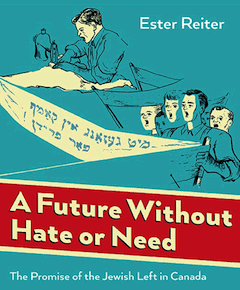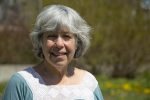Prof. Ester Reiter, author of A Future Without Hate or Need, points to the U.S. election as a warning that the issues the Canadian Jewish left dealt with are as timely as ever. (photo from Ester Reiter)
On Dec. 1, Prof. Ester Reiter will speak at the Peretz Centre for Secular Jewish Culture to launch her new book A Future Without Hate or Need: The Promise of the Jewish Left in Canada (Between the Lines, 2016).
Reiter’s book documents “the varied political and cultural activities of those who were part of the secular Jewish left” – the movements in which many Yiddish-speaking immigrants and their children took part during the first half of the last century, made up of Yiddish schools, theatres, choirs, dance troupes, drama groups, sports leagues, union activism, newspapers, women’s groups and summer camps. Their members were animated by a vision of what many of them would have called a shenere, besere velt (a more beautiful, better world). There were groups throughout the country, with the strongest ones in Montreal, Toronto and Winnipeg.
Many of these groups came together nationally in the United Jewish People’s Order (UJPO), founded in 1945. The book launch is being undertaken to commemorate the 90th anniversary of the founding of the Labor League – which later became part of UJPO – in Toronto in 1926. The launch is sponsored by UJPO, and co-sponsored by the Peretz Centre and the Shaya Kirman Memorial Foundation for Yiddish Culture. It will start at the Peretz Centre at 4 p.m.
Reiter, a sociologist by training and a senior scholar at York University in Toronto, grew up in New York in a milieu similar to the one she describes. “I grew up in the New York left, the sister version of the Canadian Jewish left. I was a child in the Yiddish shule [school] in Brooklyn and later the mittlshul [middle school] in Manhattan during the Cold War. Many of my teachers were well known in Canada – they were in the summer camps in Montreal and Toronto, and taught in Canada. The politics were virtually the same and shule materials used in Canada were produced in New York, particularly in the early years, the 1930s.”
This community was at its strongest from the 1920s to the 1950s. Yiddish-speaking immigrants were immersed in the secular Yiddish culture and literature that emerged in the late 19th century. “The Jewish left was the equivalent of a university for working-class women and men. The cultural activities – dance, choirs, orchestras – were accessible to both women and men. People working in the needle trades with no time to learn to read music would sing classical works in the choirs, learning them by heart.”
Reiter says of the Yiddish Arbeter Froyen Fareyn (Jewish Women’s Labor League) that, “the very act of getting together changed many of the women,” particularly in women-only groups, “where women felt more comfortable, they described how they learned to speak in meetings. Their political commitments, which involved activities such as walking picket lines, raising money for various causes, necessitated engaging in public life in a way that required and reinforced self-confidence. This participation in the wider world was empowering. They supported each other, made close friendships and had a lot of fun.”
Jews on the left in Canada, as elsewhere, were diverse – they included social democrats, Bundists, anarchists, Labor Zionists and Marxists. Reiter focuses on those whose outlook was Marxist and supported the Soviet Union after the 1917 October Revolution.
 Reiter emphasizes that this sector of the Jewish left had a life of its own distinct from the Communist party. “The leadership were Communist party members, but approximately 95% of the membership of the UJPO and its predecessors were not. One could think and say what one felt in the Jewish left without concern over whether it was the ‘correct’ position. Many people came [to the Jewish left] because of the liveliness of the community, as well as the politics.”
Reiter emphasizes that this sector of the Jewish left had a life of its own distinct from the Communist party. “The leadership were Communist party members, but approximately 95% of the membership of the UJPO and its predecessors were not. One could think and say what one felt in the Jewish left without concern over whether it was the ‘correct’ position. Many people came [to the Jewish left] because of the liveliness of the community, as well as the politics.”
Initially, Yiddish schools saw their purpose as conveying ideological values, but this later shifted to transmitting the Yiddish language and Jewish cultural identity for their own sake, including secularized versions of Jewish holidays and rituals. “In the early period, a Yiddish education in the shule was to ensure that the children learned they were the children of workers, and needed to care about racism and class exploitation. After Hitler came to power and antisemitism was growing, Yiddish was valued as an end in itself, and there was more acceptance of the different ways of identifying as a Jew. The community developed secular ceremonies around the bar/bat mitzvah, the High Holidays, Rosh Hashanah and Yom Kippur.”
The Jewish left experienced government harassment during the Cold War, especially in Quebec under premier Maurice Duplessis. Reiter notes that Canadian Jewish Congress defended civil liberties in the face of repression, but “dealing with pro-communist groups in their midst was a different matter.” UJPO was expelled from CJC in 1952 for dissenting from the Cold War consensus by opposing the postwar rearmament of West Germany and supporting the Stockholm peace petition.
The Jewish left for a long time saw the Soviet Union as a hope for a better society, in its outlawing of antisemitism and support for Yiddish culture in the 1920s, but their hope was shattered by the Stalin regime’s murder of Yiddish artists in the late 1940s and early 1950s. “For many years, people projected their idealism on[to] the USSR. When they found out about Stalin’s suppression of Jewish life, it was shocking. Most of the Jewish [Communist party] leadership from UJPO left the party. However, the rank and file in UJPO were never actually party people, so many felt that, although the USSR under Stalin was terrible, their activities in Canada – helping the unemployed, union support – were important and valuable.”
Reiter describes various factors in the shrinking of the Canadian Jewish left – Cold War persecution, disillusionment with Stalinism, the erosion of Yiddish by assimilation. However, UJPO itself has survived the disappearance of the milieu that gave birth to it, and has even attracted new members. Reiter reflects, “There certainly is a need. Our politics mean that we are inclusive of different kinds of families – gay, straight, trans, mixed racial and religious origin. Yiddish has pretty well disappeared, but the progressive politics remain. With respect to Middle East politics, there are a variety of views in the UJPO, but we all agree that criticizing the actions of the Israeli government does not mean that one is a self-hating Jew. We also continue with trade union support, First Nations solidarity, environmental activism. We exist because we have a community that has a good time together. As the organized Jewish community has moved to the right, we provide a place where one can have a Jewish identity and be progressive. Secular left Jews now have to think about what we have in common, not what separates us.”
Reiter points to the Nov. 8 U.S. election as a warning that the issues the Canadian Jewish left dealt with are as timely as ever. “The struggle against racism, sexism, homophobia and all this meanness and narrowness is an ongoing one – a call to remember and honor and value our own history and where we came from.”
Carl Rosenberg is a member of the United Jewish People’s Order and Independent Jewish Voices Canada. For many years, he edited Outlook: Canada’s Progressive Jewish Magazine.

